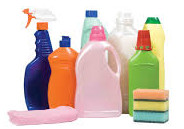Recently, we discovered our new dog is allergic to something in our home. Needless to say we have been on the hunt for anything that could be causing this issue. Since it is just the two of us, the house stays pretty clean already. We feed him natural foods, he is bathed in an oatmeal based shampoo. So, this has led us to the environment in our home, especially since it’s winter and the house is pretty much closed up most of the time.
Chronic exposure to ingredients in a bunch of household products that might be around the house and are used daily, such as air fresheners, etc. have been linked to a wide range of health problems from headaches to asthma and even cancer. We have been slowly getting rid of these types of products in favor of something more safe and natural. This situation has prompted us to pick up the “pace”. So to speak.
“Volatile organic compounds”, or VOCs, are in vapors that come from many everyday household products, such as cleaners, paints, air fresheners, etc. The effect of VOCs on you and your pet’s health depends on a number of variables, including how many hours are spend at home, your storage habits, and airflow patterns in your home. VOCs are so widespread, you can’t get rid of them entirely. Use low-VOC products and increase ventilation when you use them.
Step 1: Buy only what you need
When it comes to household chemicals, don’t buy in bulk to save money. Buy only what you need. Stored chemicals are a major source of VOCs, even when the container is closed up tight. Buy the low-VOC versions of products. Many “green” brands are only slightly more expensive, or better yet, make your own “green” version of the product if possible.
Step 2: Store “foul-smelling” stuff in a detached garage/shed
Paints, paint thinners, pesticides, and gas cans are a major source of VOCs. The further away from your house you store these foul-smelling items, the better. We store our “foul-smelling” stuff in a detached garage. We also use it to store gas-powered tools, lawn mowers, snow blowers, etc.
Step 3: Seal off your attached garage
If you have an attached garage, then you’ve got vehicles with VOC-producing gas tanks right next to your living area. Plus, if a detached shed isn’t an option, you’re likely to use your garage to store your chemicals, gas cans, and other VOC products. If that’s the case, seal up any connections between your garage and living area. Weather-strip your garage access door, and make sure that the threshold gasket is snugged up tight. Not all connections are going to be obvious. Look for holes around ductwork. Seal up these gaps with caulk and foam sealant.
Step 4: Your nose really does knows
Weather permitting, open windows and maybe run exhaust fans when you’re working with paints and any type of pungent cleaners. Trust your nose; if you can smell it, you and the family are breathing those VOCs. If weather permits, remove covers and packaging from items and set them outside for a while to off-gas…at least until they don’t smell. Schedule major interior paint jobs for good weather so you can open up windows.
Step 5: Exhaust your possibilities
Bathroom and kitchen fans are great for removing VOCs from the air, especially because cooking and cleaning can release some pretty potent compounds. Be careful, running your exhaust fans constantly can create negative air pressure inside the house, which may actually draws air into the house from places like your attached garage. Run fans until any smell dissipates, then turn them off. If you use your garage as a regular work area for VOC-generating hobbies, install an exhaust fan to the outside.
Step 6: Ditch the air fresheners
There is mounting evidence against plug-in and spray air fresheners. Many emit chemicals and ultra-fine particulates that may not be identified on the label. Some also contain terpene, a fragrant chemical that’s widely found in natural substances, such as pine resins. But when confined inside a house, terpenes react with naturally occurring ozone in the air and form compounds that have long-term effects on the respiratory system. Don’t forget the air filters in the house. Changing the air filter in your home will help clean the air.
Since taking these steps, and going through our home, we are all breathing and feeling much better. Even our new dog seems happier, and is doing much better.
